

The best part of the recently concluded exhibition Me We, and the artworks it showcased was the stern refusal to be pigeonholed into one category or another, writes Dibyajyoti Sharma
What’s queer art, anyway? Let’s just say that today, it defies an easy answer. However, one thing is clear. It’s no longer just about alternative sexuality; it encompasses broader issues of identity. This is especially true of visual arts. For years, there seemed to only two ways of representation — erotic and political, that is, if an artist received the opportunity to represent at all. For years, the only queer artist we knew seemed to be Bhupen Kakkar. Despite his strong academic antecedents and his obvious genius, it took him years to receive recognition. Then we had the stark photographs of Sunil Gupta, and political performances of Inder Salim, and intimate paintings of Balbir Krishan. But somehow all their works remained fringe curiosities, fodders for easy controversy which the mainstream press could convert into ‘news’ and move on.
All this is about to change with the recently concluded exhibition, Me We (notice the obvious mirror reflection of the two words), a visual arts exhibition curated by Engendered and presented by the American Center which was on view from 26 June to 8 July at the American Centre, Kasturba Gandhi Marg, New Delhi.
Myna Mukherjee of Engendered explained, “The idea behind the show was to move away from the status quo, not just in terms of representation, but also in terms of dissemination, where art is available, not just galleries, but also in emerges spaces like Instagram. We tried to incorporate all sorts of diverse factors. That obviously led us to include voices that are expressed not just through the lenses of identity and sexuality, but also through the lenses of binary codification of gender. In short, we wanted to include artists who celebrate the sense of being different.”
True, being different is the exhibition’s raison d’etre. But what caught our attention was how this difference manifests in the artists’ works. For one thing, queer art is no longer camp, but a serious endeavour. The exhibition proves that queer identity in India today is a many-splendoured thing, an idea which was literally explored by two artists from two diametrically opposite points of view.
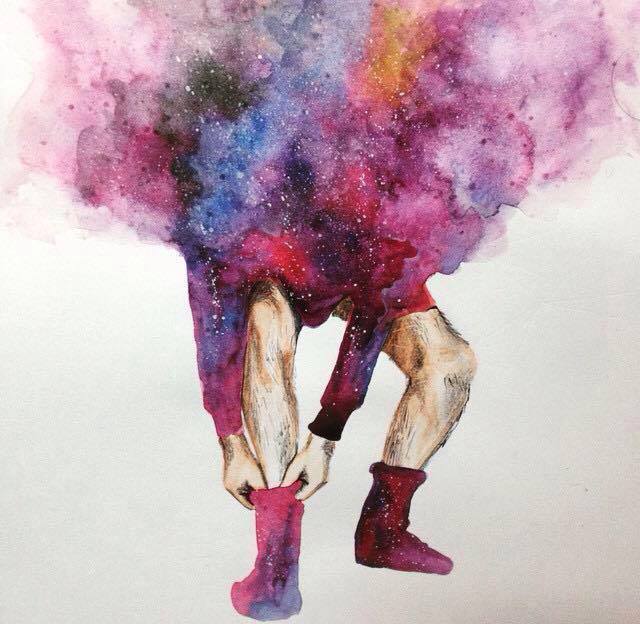
Wearing the Cosmos, Aditya Raj
Aditya Raj’s watercolour on paper titled Wearing the Cosmos shows a young man trying on socks as his upper torso explodes into multicoloured, star-filled cosmos. It’s an intriguing piece of work, like all his other pieces at the exhibition, were we notice the body of the subject but not his face. The face becomes the universe. There are different ways to read this, especially in Indian context, where being queer is still a criminal act (how the criminals are escorted to the court with their faces covered) and also a matter of shame. It’s interesting how Raj takes this idea of the hidden face and positivises it to incorporate the whole of cosmos.
On the other hand, Renu Sharma’s watercolours and gouache on paper Turning In is about finding the universe within, when we are one with the universe. It begins with a standard portrait of a woman defiantly looking at the viewers as her clothes reveals the aspects of the space itself. The work is a bold statement on connecting at different level, first with the body, then with the outside, and finally to encompass the whole of existence.
This idea of finding a body that suits the identity and celebrating the difference of the body is the theme of several other artworks. Gargi Chandola’s digital painting Trans Passing is a literal shedding of identity to reveal another, where we notice a changing room, with a man’s clothes strewn across and his face as a mask discarded on the floor, as the standing figure remove his skin as if it’s a body suit to reveal a intriguing and colourful female aspect inside.
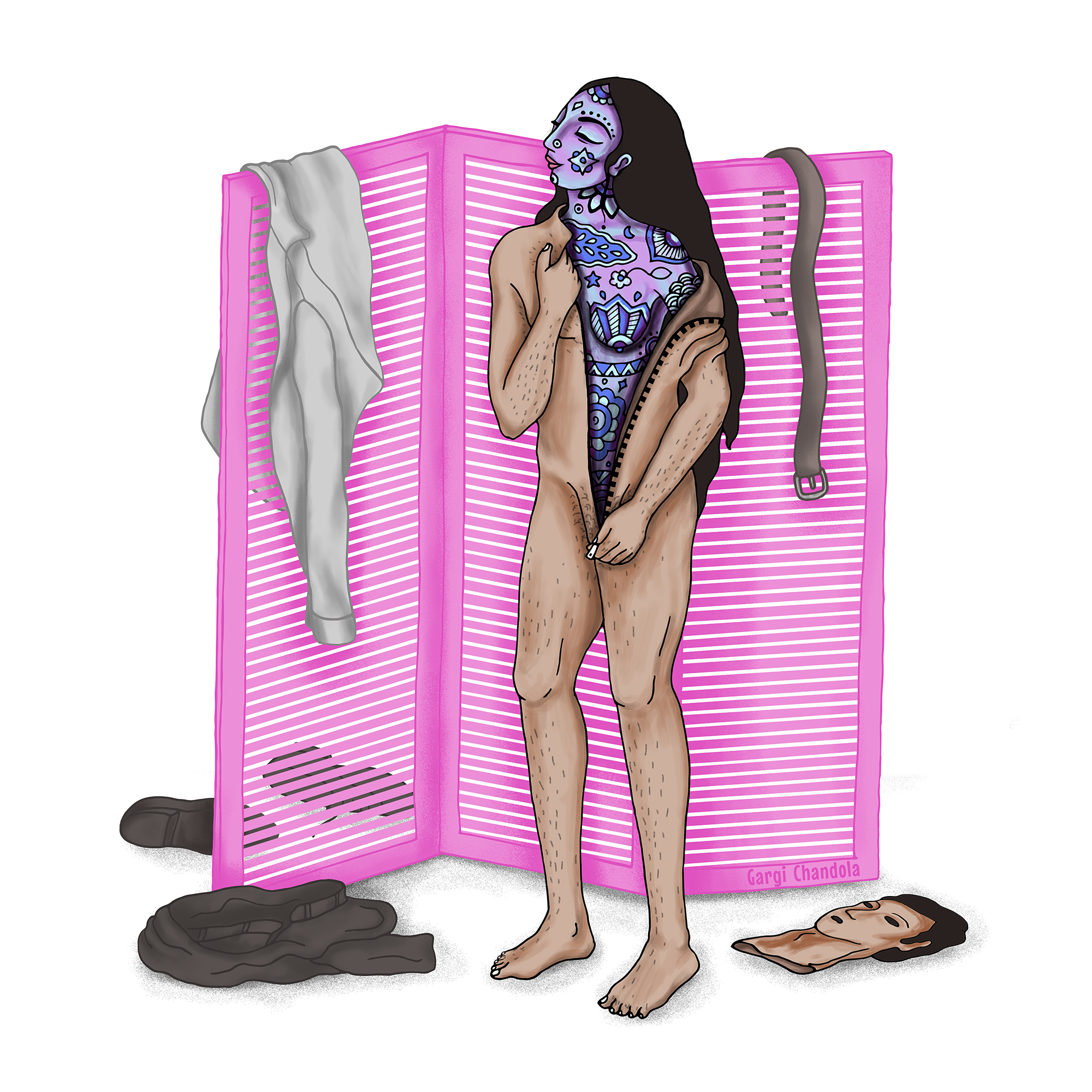
Trans Passing, Gargi Chandola
A series of four paintings by Balbir Krishan also explore the possibilities of trans-identity. It begins with post-apocalypse like landscape with a figure in a gas mask on. As you are drawn to the intricate design of the artwork, you notice how a flower has sprouted on the other end of the mask. This tonal shift from hopelessness to hope, finding an opportunity to thrive even in the most oppressive of situations is at once surprising and heartening. Elsewhere, Manmeet’s photograph, Hidden, plays with the idea of a woman with literal balls.
Celebrating Diversity
It’s very easy for a group show like this to appear lopsided, focusing on certain aspects and ignoring others. To its credit, Me We went out of its way to bring in the diversity in both presentation and representation.
So you had standard works, paintings, and photographs, but also other forms — a brass tongue behind a pair of scissors and nails to represent how minority voices are silenced; installations featuring a scrapbook to represent hidden designs (one intriguing shot shows a newspaper with the photograph of a dead militant, half-naked. How the image incorporates violence and eroticism within the same space is striking.); a GIF image; a mannequin wearing a designer burqua, with a mirror for the face, to reflect the visitor’s face on its own; and a comic strip which re-imagines the Cinderella story, where she is a man in drag. Never mind, the story ends in happily ever after mode and it’s brilliant.
“We obviously wanted to have established artists on our show to offer a sense of history, but we also wanted to have artists from across the country, from small town and villages.” Mukherjee said.
These new artists brought a unique flavour to the show, where queerness is just an aspect of the artist’s personality.
Nikhil Bansal’s work which is inspired by Persian miniatures, an art form he confidently appropriates for his purpose. In Let Me Fly, we have a Kathak dancer and his mirror image, in darker shades and in wings, in a background which will typically represent a heterosexual scene.
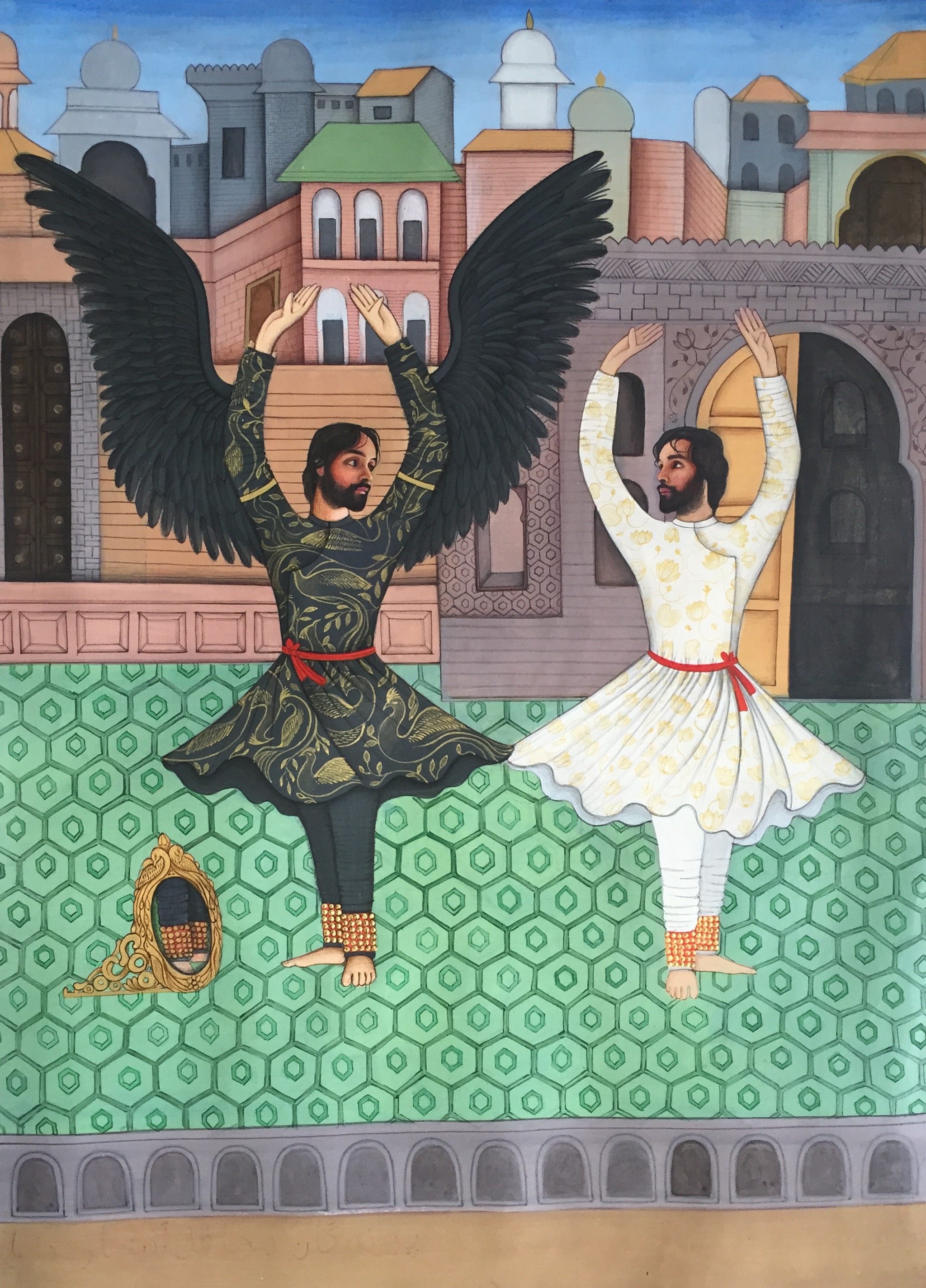
Let Me Fly, Nikhil Bansal
Another painting by Aamir Rabbani shows a scene of furtive lovemaking between the sheets. However, what draws your attention is the top of the canvas, with trousers, shirts, bags, hanging from the walls, a single man’s room in the city, finding home away from home.
In brief, the exhibition celebrated the unconfinable and unflinching individualism of 25 artist voices, self-identified as queer. Mukherjee said the artists are working at the intersections of identity and life experience, genre and process. “Shattering mythologies of desire and intimacies, the works range from polished and seasoned to raw and sometimes even incomplete, exposed as they are to the vulnerability of love and loss that is immediate and personal,” she added.

Mohan Jangid, I Am Sacred, Thread wrapped on wooden letters
The show had iconic photographers like Ram Rahman, Sonia Khurana, established artists like Balbir Krishan, Valay Gada, and Inder Salim, Satadru Sovan, emerging art feminists like Gopa Trivedi, Manmeet Devgun and Gargi Chandola (post-art project), radical young voices like Indira Lakshmi Prasad and Aditya Raj, Mohan Jangid, fearless new artists working at the intersection of religion and sexuality like Aaamir Rabbani & Adil Kalim, fierce young women artists from the North East like Jenny TS and Baishali Chetia; classical and renaissance painters like Saawan Taank, and Nikhil Bansal, the new millennial sketchers, illustrators and graphic artists, sci-fi fantasy makers and new media warriors like Ipshita Thakur, Pulkit Mogha, Oddbench and Renu Sharma and writer Dhritabrata Bhattacharjya Tato.
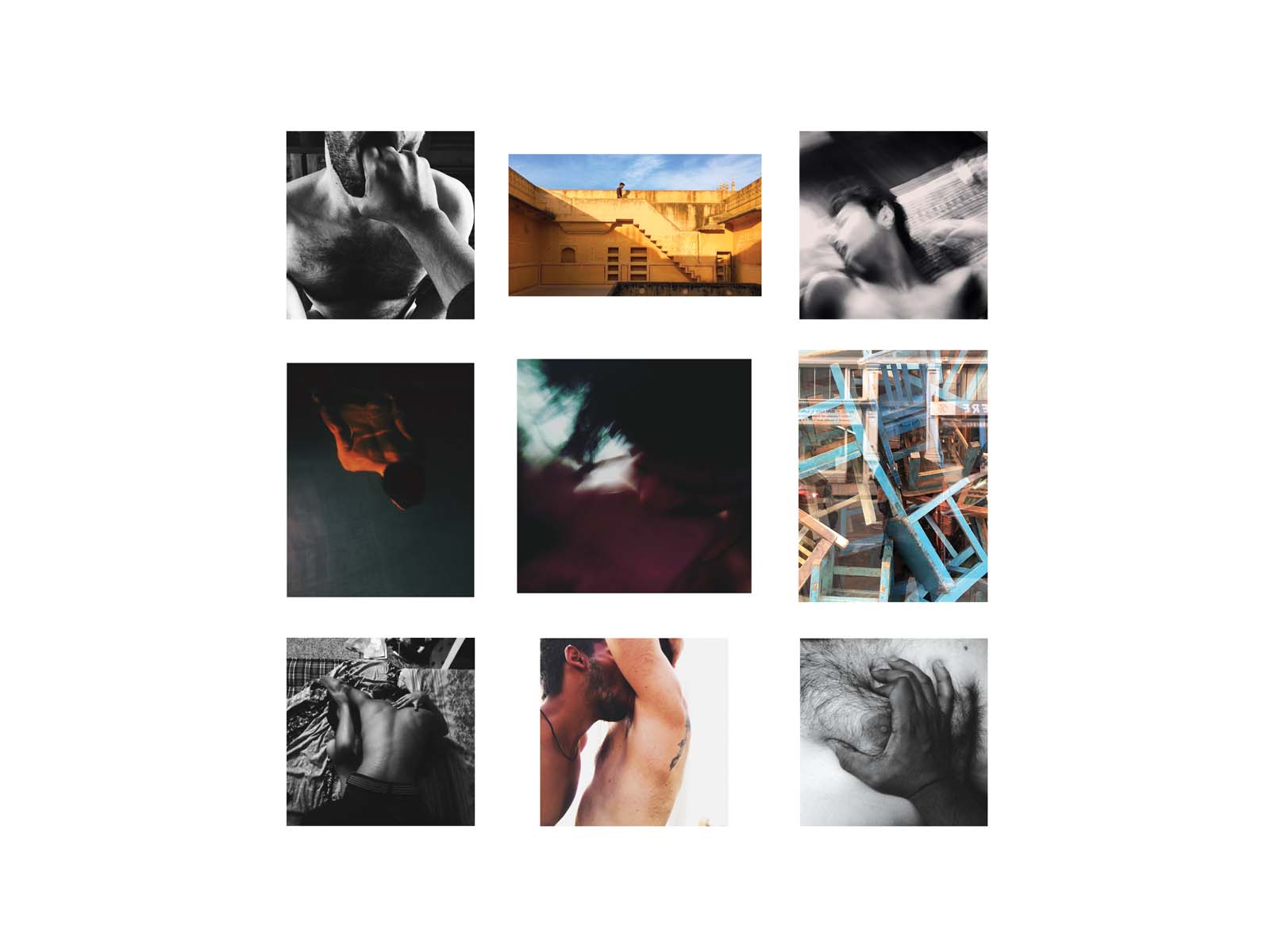
Pulkit Mogha, Thirsty
The best part of the show, and the artworks it showcased was the stern refusal to be pigeonholed into one category or another. It’s all fluid and personal and political at the same time. In the context of the current political scenario, where gay sex is a crime punishable under IPC 377, lesbian desire is silenced and trans-identity is pushed to the margin, the exhibition offers a window to another India that shimmers just beneath the surface, expressing their desires through their art. For this, the credit must go to Engendered, a transnational arts and human rights organisation exploring gender, sexuality, culture and religion in south Asia, for giving the artists a safe platform to explore their art. As non-normative art forms, especially visual arts, are in the danger of courting controversy in a public platform (which often leads to vandalism), Mukherjee said she needed to find a safer space to showcase the works, and the American Center fitted the bill. At one level, the strategy works. Take for example, Saawan Taank. A local artist from West Bengal and trained in Shantiniketan, he found a safe platform to explore his ideas of BDSM in art, in two explosive canvases, an opportunity he wouldn’t perhaps find elsewhere.
What I found fascinating about Taank’s work is how he takes a fetish, which is essentially a ‘western import’, and makes it unrecognisably local, his own.
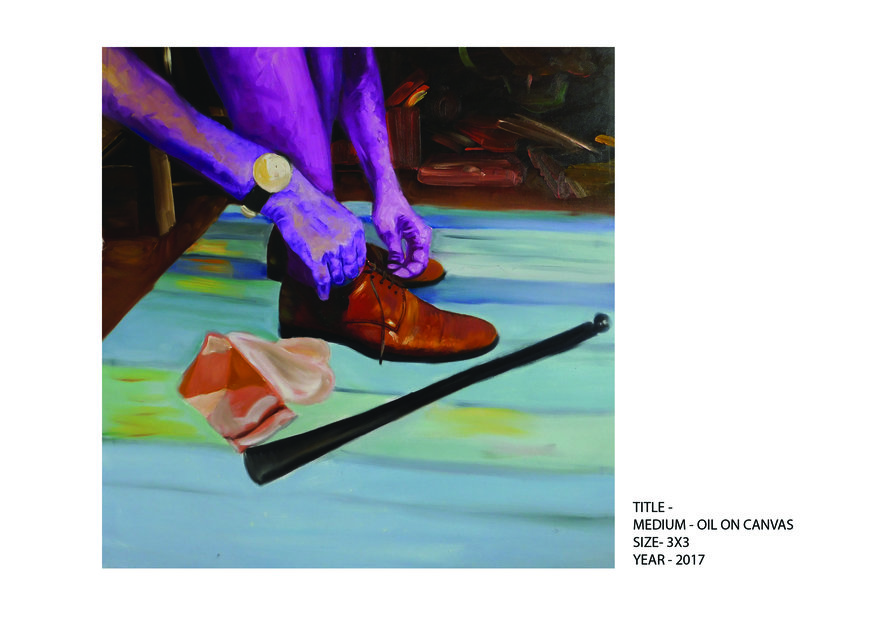 Without recognisable role models at home, for a long time, the queer subculture in India has borrowed heavily from the west, especially America, because of its easy accessibility. At this show, however, to my utter surprise, I did not find any recognisable western influences. There are influences to be sure, for example, Jenny TS’s works will definitely remind you of Frida Kahlo, but the representation is more immediately, more local. For example, Jenny is trying to subvert the male-dominated myths of her state, Manipur. In the process, her lived experiences overshadow her borrowed influences. This immediacy and this lenses of personal experiences through which the artists explore their queerness is what made the show stand out.
Without recognisable role models at home, for a long time, the queer subculture in India has borrowed heavily from the west, especially America, because of its easy accessibility. At this show, however, to my utter surprise, I did not find any recognisable western influences. There are influences to be sure, for example, Jenny TS’s works will definitely remind you of Frida Kahlo, but the representation is more immediately, more local. For example, Jenny is trying to subvert the male-dominated myths of her state, Manipur. In the process, her lived experiences overshadow her borrowed influences. This immediacy and this lenses of personal experiences through which the artists explore their queerness is what made the show stand out.
The author is a journalist and a teacher. He has co-edited Whistling in the Dark: 21 Queer Interviews (Sage, 2009) and published two volumes of poetry, beside numerous writing credits in journals. Based in Delhi, he runs an independent poetry publishing venture Red River.